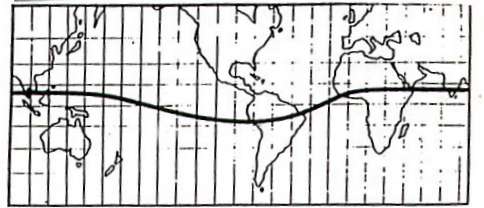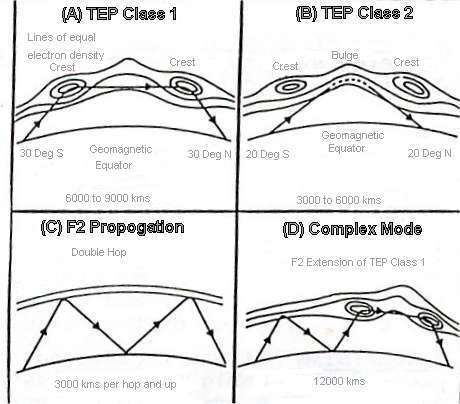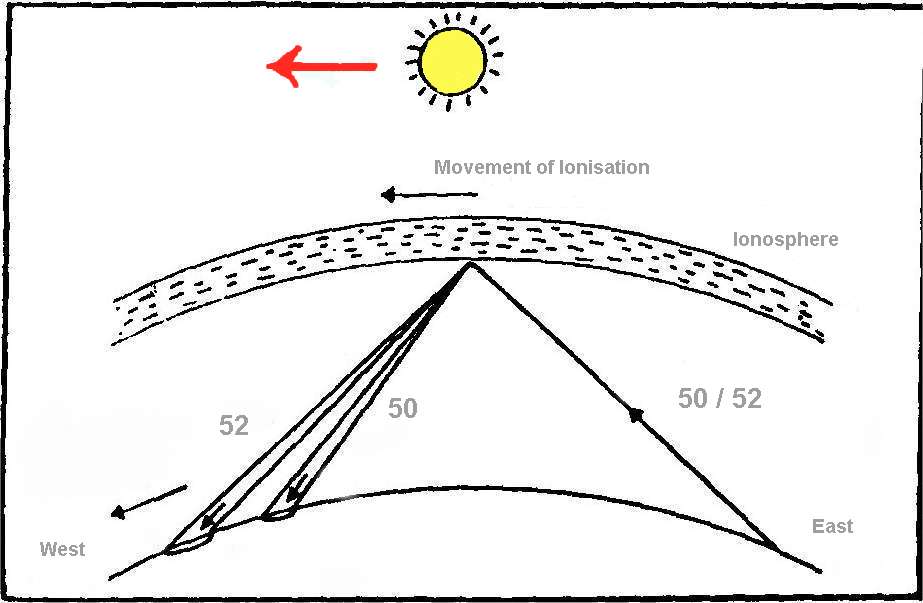
By Stephen Wright, EI5DD
During the peak of Sunspot Cycle 21, the years 1979 - 1982, astute six metre operators experienced conditions that enabled worldwide DX to be worked. The availability of equipment, the usage of HF liason, the awareness of an increasing number of operators, and a better understanding of the pecularities of the band have contributed to make the six metre band a DX band in its own right. Some overseas operators have worked over seventy countries on six metres. (Written around 1988 - EI7GL)
For the purpose of this article, Long Haul DX will be defined as that worked via Trans-Equatorial and F2 propogation and other complex modes such as backscatter and Sporadic-E extension.
Looking at the worldwide picture, some remarkable paths have been found. It is interesting to note that these paths were not spasmodic and random, but were found to be repeatable day after day at the same time each year.
TYPICAL PATHS ACHIEVABLE ARE SHOWN BELOW,
1) South Africa to Hawaii via The Southern Indian Ocean and The Pacific.
2) Solomon Island to Peru via The Pacific.
3) Queensland to Acension Island believed'to be via Northern Canada.
4) Canada to India via Asia (To the East).
5) Canada to New Zealand via The Pacific.
6) Japan to Argentina via The Pacific.
7) Sydney to the Caymen Island (Caribbean) via The Pacific.
8) Fiji to Kenya via The Pacific and Atlantic.
9) Hamilton (Victoria) to the British Virgin Island via The Pacific.
This is only a small sample of the DX that has been worked on six metres during the period of time and most of it was worked by operators who, by careful observation and study of band characteristics, ment that they were there when band conditions were likely to open.
Six Metre Seasons
The Sporadic-E seasons occur during the months of Summer and Mid Winter that allow DX to be worked at reasonable signal strenghts and this can produce many interesting contacts.
However, during the years close to the peak of the sunspot cycle, when the sun emits increased ultra-violet, x-ray radiation, proton and other emissions, there are two more six metre seasons each year. These are the Equinox periods, in March and April, and in September and October. The latter being better in the Northern Hemisphere and the former in the Southern Hemisphere.
Solar Flux and the A and K Indices
Solar Flux : This is a measure of the Sun's radiation at 2,800 MHz taken daily in Ottawa.
The flux figure correlates well with the ionisation density of the ionospheric F region and indicates the Maximum Usuable Frequency (MUF) for DX communication. A solar Flux of 66 represents a quiet sun during the lowest years of the sunspot cycle and the figure may reach 300 or more during the peak. A flux of 383 was recorded in 1979.
The A Index : This is a twenty-four figure for the activity of the Earth's geomagnetic field on a scale of 0 to 400 or so. A quiet magnetic field (A index of 10 or less) characterises the best HF propogation conditions due to the low absorbtion of wave energy. It has been noted that a magnetic storm producing an A index of 30 or more may produce a six metre DX opening a day or so after the event during the Equinox periods.
The K Index : This is similar to the A index except that it is as near to a current figurre that can be given. For a given magnetic observatory, measurements of magnetic activity ranging from 0 (very quiet) to 9 (extremely disturbed).
In six metre propogation forecasting, it has been observed that Solar Flux figures between 170 and 240 produce the best results in Sydney. However openings have occured to America with a flux as low as 145. Above 240, very little DX seems to reach Sydney although there is still plenty happening in the tropics. High A indices of about 30 or more (K = 4) may indicate a probability of DX within a day or so.
The Propogation Modes Involved. Before considering the propogation modes involved, one should be familiar with the Geomagnetic Equator. This is a line of zero magnetic dip as shown in Fig. 1.

|
| Fig. 1 |
It is the geomagnetic equator and the corresponding geomagnetic latitude that must be considered when investigating radio propogation , particularly via the trans equatorial modes.
Trans Equatorial Propogation (T.E.P.)
Afternoon Type or Class 1 T.E.P.
Zones or crests of enhanced ionisation form between 10 and 20 degrees geomagnetic latitude in the morning hours of days of high solar activity, i.e. near the Sunspot Cycle peaks. If the days are too close to the equinox periods (March/April and September/October), these crests are more evenly distributed either side of the Geomagnetic Equator. Signals transmitted from one side of the equator can be refracted by one of the crests to the opposite crest and then refracted back down to the earth into roughly the same geomagnetic latitude. This provides considerable distance in one hop without an earth reflection. (See Fig 2.A )

|
| Fig. 2 |
Class 1 T.E.P. shows the following : - A peak occurance around mid to late afternoon (12:00 - 19:00 Local mean time) measured at the point where the path crosses the geomagnetic equator. Normally strong steady signals with a low fading rate. A focusing often takes place as the signal is returned to earth providing considerable frustration to amateurs who may find that only a few kilometres are necessary to turn a strong signal to a weak and unreadable one. Path lenghts of 6,000 to 9,000 kms and sometimes longer are possible.
Evening type of Class 2 T.E.P.
This very interesting phenomenon of the equatorial ionosphere is still not totally understood. It is generally believed propogation takes place inside giant ducts (resembling huge inverted bananas) that are formed by areas of depleted ionisation lying along the earth's magnetic field lines, and spanning the geomagnetic equator. A signal injected will propogate by a process of internal reflection (See Fig 2 B)
Class 2 T.E.P. shows the following characteristics : -
A peak occurance around 20:00 hours to 23:00 hours local mean time. High signal strenghts but with deep rapid fading or flutter accompanied by a doppler spread of plus or minus 20 to 40 Hz. Path lenghts shorter than Class 1 being around 3,000 to 6,000 kms and sometimes longer. This class of T.E.P. is less tolerant in the angle of the equatorial crossing, only a few degrees off a right angle being needed to prevent propogation.
Propogation via F2 Layer Refraction
This is simple refraction through the F2 layer (about 300 kms high) and back to earth during periods of high solar flux when the M.U.F. (Maximum Usuable Frequency) for a particular path reaches 52 MHz or higher. Multi-hop propogation is possible (see Fig 2 C). Strong stable signals occur and it will open at the same time each day for as long as the solar conditions remain favourable, perhaps for a week or more.
Backscatter
This is really a form of F2 propogation and this occurs because the ionosphere acts very much like a mirror when operating very close to the M.U.F. for a particular path. A certain amount of signal is scattered from the ground after an F2 hop and a small portion returns via the same path. Stations that cannot normally comunicate due to distance e.g. several hundred kms apart will be able to work one another providing all beams are pointing in the same direction into the scatter zone. Sporadic-E propogation can also result in backscatter contacts being made.
Complex Modes
Very often, two or more propogation modes can combine. For example, T.E.P. signals that may not normally reach Southern Australia have been extended by Sporadic-E propogation or F2 layer propogation (See Fig 2D). These complex modes are sometimes unreliable and short lived. It is a case of he who hesitates (or talks too long) losing the contact, and causes others to miss out also. It is not unusual for an opening to go from no signal to s9+ and then drop out in less than a minute or so. It generally means that the skip zone has moved on as it snakes accross the country. Shortly after the signal is lost, another operator elsewhere will derive the benefit of the brief opening if he is alert.
Frequency Selectivity of DX Openings
It was noted during the sunspot cycle (1979), that the frequencies at the low end and the high end of the 50 MHz band propogated differently through the ionosphere and the resultant skip zones were often far apart. Related observations in Australia showed the following results: For T.E.P. and F2 propogation signals reaching Sydney from accross the Pacific, the distance between the 50 and 52 MHz skip zones were often betwen 1,000 and 2,000 kms. The 52 MHz skip zone often arrived first i.e. the band opened at 52 MHz first. If one was listening for the band to open at 50 MHz by the time it did, it was often too late to make a QSO. Band openings were observed where there was no propogation at 50 MHz at any time. A logical extension of the previous observations tends to suggest that it should be possible to assist a marginal contact by changing frequency. In so doing, the skip zone will be moved to favour the distance one is trying to work. Lower the frequency to shorten the skip and raise the frequency to lenghten it (See Fig 3).

|
| Fig. 3 |
Conclusions
It has been found that the peak years for six metres activity follows the Sunspot cycle peak by 2 to 3 years. The peak of cycle 21 occured in december 1979 and correllations of results have proven that the Autumn equinox in 1981 yielded the greatest number of DX openings and the strongest signals on six metres. Studies indicated that the solar flux had little to do with DX openings on a day to day basis.However, on almost every occasion of magnetic activity with an A index over 30, a DX opening occured within a day or so. This may be coincidental since there were many other openings with low A index figures. The years 1979 and 1980 did not appear to produce as many DX openings as 1981 and 1982. It was observed that the A index did not exceed 30 as it did during the latter years and also there was a considerable lack of magnetic activity in the former years. It is said that Sporadic-E openings are more abundant in years of low solar activity. We are heading towards the next sunspot maxima and this will be the first chance to experience such conditions since the EI licence has been extended. Monitoring of the propogation broadcasts transmitted by WWV at eighteen minutes past the hour will provide valuable information.
References :
ARRL Handbook
UKW Berichte
Amateur Radio Action
VHF Group Newsletter
 Back to the index page
Back to the index page
| The URL of this page is http://www.qsl.net/ei7gl/ei5dd6m.htm | Last Modified : 22nd Sept 2003 |